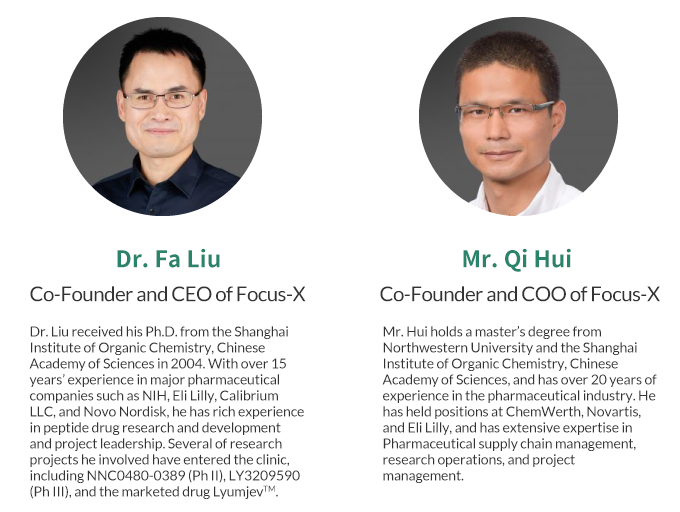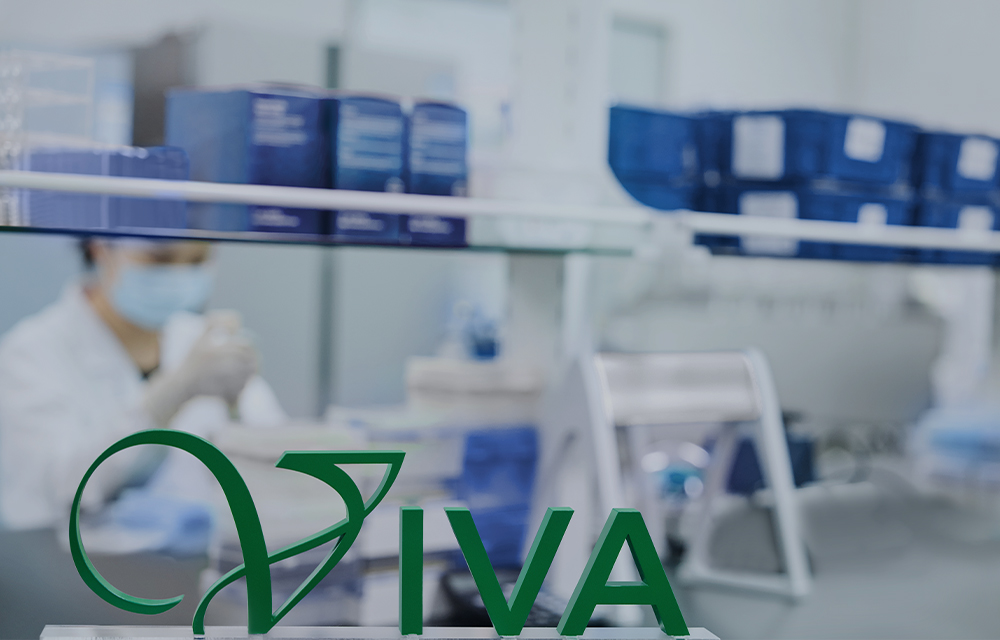Radioactive Ligand Therapy (RLTs), as an emerging and precise method for cancer treatment, has the advantages of precise targeting, strong killing power, and limited damage. To date, it has become an essential means of tumor diagnosis and treatment. Due to its broad application prospects, an increasing number of large pharmaceutical companies and biotech firms are focusing on this field.
Recently, Focus-X Therapeutics (hereinafter referred to as "Focus-X"), a Nuclide Drug start-up invested and incubated by Viva Biotech, successfully reached an acquisition agreement with Full-Life Technologies Co., Ltd.. Established in 2020, Focus-X Therapeutics was led by Viva Biotech in the third quarter of 2020, providing comprehensive incubation services. In just two years, it has achieved several breakthroughs and transformations of clinical candidate molecules from scratch.
So, how has Focus-X quickly achieved the transformation from concept to product? How was the successful acquisition achieved? And what are the future trends in this field? Recently, we interviewed Dr. Fa Liu, co-founder and CEO of Focus-X, and Mr. Qi Hui, co-founder and COO, both with many years of experience in this field. They provide responses and answers in order to bring enlightenment and help to all.

Q: In just two years of its establishment, Focus-X has successfully established an innovative peptide-drug conjugate (PDC) platform and used it to advance multiple nuclide-conjugated drug pipelines to the IIT stage for radioligand therapy (RLT) development. In your opinion, what do you believe has been the key factor in the company's rapid development?
Dr. Liu: I believe it is our strategy-- focus. The name 'Focus-X' has a dual meaning: the first being the characteristic of our molecular form - peptide-oriented radiopharmaceutical therapy, and the second being the company culture of focusing on key issues at the strategic level. The latter is particularly important, as my experience at MNCs such as Lilly and Novartis, as well as the start-up, Calibrium, has made me very clear on the strategic positioning of Focus-X. Unlike MNCs, we need to concentrate our limited resources of capital and time on finding and addressing the key issues of each project, in order to effectively differentiate our pipeline. Of course, this differentiation must be future clinical advantages that can be predicted, such as improved efficacy and a larger treatment window.
Mr. Hui: I believe that efficiency in execution is key. Since our establishment two years ago, we have adopted an FTE (full-time equivalent), asset-light model including for chemistry, biology, and later clinical services. Our chemistry team began synthesizing compounds within the second week of our establishment, the biology team began cell experiments in the second month, and we prepared early on for exploratory clinical trials. Additionally, high-quality research and development partners are crucial to our success. We spend a lot of time carefully researching various CRO companies and selecting the best partner for Focus-X. To us, Focus-X and our partners have an FTE plus relationship, where they are not part of our internal team, but their efficiency in execution is equivalent to that of an internal team. Dr. Liu has often said that the chemistry team at Viva is stronger than his own internal team when working at an MNC.
Q: Focus-X is developing two major products for the treatment of metastatic castration-resistant prostate cancer and pancreatic cancer. What are the advantages or differentiations?
Dr. Liu: The approval and launch of Pluvicto® marks a second milestone in the treatment of solid tumors with radiopharmaceuticals. According to published data, the overall response rate (ORR) in clinical VISION treatment among all enrolled PSMA PET-positive patients is 30%, but there is still significant room for improvement with Pluvicto®. PSMA-Ac225, a clinically validated means of improving efficacy, is the main focus of our development and a clear differentiation from Pluvicto. In addition, our greatest differentiation among all PSMA-Ac225 products is lower enrichment in the human salivary gland. The salivary gland is a dose-limiting organ for PSMA-Ac225, and currently in clinical studies of PSMA-617-Ac225 and PSMA I&T-Ac-225, dry mouth due to salivary gland enrichment has resulted in treatment withdrawal in 10%-25%. In comparison, our PSMA-Ac225 is expected to significantly broaden the treatment window.
In preclinical models of pancreatic cancer, our molecule showed higher tumor uptake and lower normal tissue enrichment in organs including the kidney and blood compared to its analogues, leading us to predict superior efficacy and safety in the clinic.
Q: From the perspective of the entire industry, what challenges do you see in the RLTs research and development field? How is Focus-X addressing these challenges?
Dr. Liu: From a scientific and clinical perspective, the most crucial and challenging issue in terms of RDC drug distribution in the body is biological distribution. Because the mechanism of radionuclides for cancer treatment is more direct, after the target is identified, radiation begins to cut the DNA chain in cancer cells, ultimately leading to cancer cell apoptosis, so its biological distribution directly determines the efficacy and safety window of RDC drugs. In fact, biological distribution is crucial for any drug, but the predictability of most drugs in terms of efficacy and safety is far inferior to that of RDC drugs, and data is not easy to collect, so the attention is not very high. On the other hand, RDC drugs have the advantage of integrated diagnosis and treatment, and we can see the distribution of the drug in the body. RDC drug biological distribution data is also the easiest to collect among all drug forms. These factors determine that biological distribution is the key to RDC drug research. We first do experiments in animals, and it is not easy to do this step well. In addition, a bigger unknown and challenge is the translation from animals to humans. Before we have human data, we have no way to effectively predict human distribution. Of course, from the development perspective, a big advantage of RDC drugs is that exploratory diagnostic clinical studies can be conveniently conducted. This data will greatly reduce the risk of formal clinical development. We adopt this approach, using our accumulated experience in peptides and peptide conjugates over the years, and using in vitro biological distribution as our key screening experiment, to quickly obtain human imaging data.
Mr. Hui: The operation of radiopharmaceuticals is extremely challenging due to the use of nuclides. Firstly, CROs and CDMOs with nuclear drug use qualifications are mainly concentrated in the United States and there are only a few in Europe, and even fewer in China. In addition, the purchase of nuclides, the establishment of nuclear drug transportation chains, nuclear pharmacies, and the establishment of CMC facilities for nuclear drug production are all full of uncertainty and challenges. In addition, the clinical approval requirements for RDC drugs in the United States, Europe, and China differ significantly. During the research phase, we comprehensively utilized the resources of relevant nuclear drug CROs in China and the United States, and actively cooperated with well-known nuclear drug research teams in the United States. This model effectively solved the needs of the research phase. For the development phase, we have formed the idea over the past two years that in order to run faster than our peers on the RDC track, we must integrate resources. Under the guidance of this concept, we joined forces with Full-Life to quickly grow and strengthen ourselves in order to stand out on the RDC track.
Q: We're very pleased to see that Focus-X Therapeutics and Full-Life Technologies have successfully reached an acquisition agreement. From the perspective of the enterprise, what do you consider to be the key factors in achieving this transaction?
Mr. Hui: We believe there are two key factors: first, high-quality PCC data and early human data; second, the high degree of complementarity between the two companies. Focus-X has built a unique target pipeline and technology platform, while Full-Life has a unique medical nuclide platform, clinical development, and financing platform. Overall, in the current financing environment, research and development companies must first ensure innovation and pipeline quality to survive or continue to grow and must have real innovation. Secondly, if seeking opportunities for sale or merger, it is crucial to find companies with strong complementary competencies. After the merger, the two sides can complement their resources to make up for their weaknesses and enhance their overall competitiveness."
Q: Viva has a strong industry-leading advantage in the field of CRO drug research and development. As a seed round investor of Focus-X, what role has Viva played in the development of the company?
Mr. Hui: In addition to being a seed round investor for Focus-X and providing financial support for the establishment of the company, Viva has also played a very important role in the development of the company in two ways: first, professional incubation services. As we all know, for a startup company, establishing a complete laboratory not only requires sufficient cash but also requires sufficient R&D personnel, which is undoubtedly a huge challenge for early-stage startups. At this point, the founder either builds on his own, sacrificing cash flow and time, or outsources to CROs. Because of Viva's involvement, Focus-X has another option, outsourcing early services to Viva through EFS, which not only relieves the pressure on cash flow, but also is seamless and saves time and cost.
Secondly, extensive post-investment consulting services. Both founders of Focus-X are first-time entrepreneurs and lack experience in company strategy, management, and operations. Viva Biotech has invested in and incubated many new drug start-ups and has a wealth of resources and connections in these areas. Viva specifically delegated Dr. Yiwen Zong, an experienced director, to Focus-X. Dr. Zong is also a successful entrepreneur and has provided many constructive opinions and suggestions to Focus-X's company strategy, management, and operations, helping Focus-X avoid many detours and enabling the development of three PCC molecules in less than two years with only two full-time employees. These are the areas where Viva has brought unique assistance to Focus-X.
Q: At present, it is generally believed in the industry that RDC is expected to become the next big thing, compared to the popular ADC track. How do you view this trend?
Dr. Liu: We share the same view. The treatment of diseases is very diverse, and no single molecular form is universal, hence the need for multiple molecular forms. We believe that the current stage of RDC development is similar to the state of the current hot ADC race 5-10 years ago. In comparison to ADC drugs, RDC has a higher therapeutic effect; specifically, for the treatment of the same lesion, the required amount of RDC molecules is 1/10-1/100 of ADC. This means that RDC can be used to target with relatively low expression levels and challenges for ADCs, in other words, RDC has a wider range of target scope.
About Focus-X
Founded in 2020, Focus-X has developed a proprietary engineering platform to develop peptide radioligands that precisely deliver alpha or beta emitters to breakdown cancer cell DNA. The platform optimizes peptide radioligand vectors for key pharmaceutical attributes such as biodistribution, binding affinity, and in vivo stability. Such optimization can present significant challenges to other ligand targeting compounds such as antibodies. The company focuses on both validated targets and new mechanisms.

